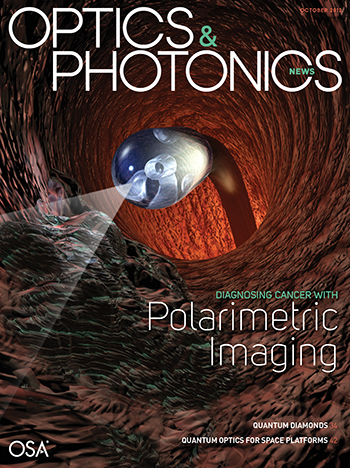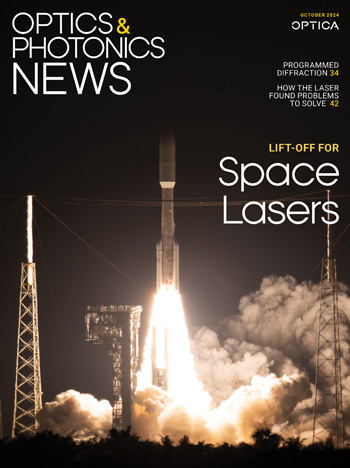
October 2012 Issue
Feature Articles
Polarimetric Imaging for Cancer Diagnosis and Staging
A medical imaging technique that relies on light polarization could become a fast and accurate optical method for detecting cancer and determining the stage of the disease.
by Tatiana Novikova, Angelo Pierangelo, Antonello De Martino, Abdelali Benali and Pierre ValidireQuantum Diamonds
Can we demonstrate quantum mechanics at scales relevant to a human being? To find out, we turned to a beautiful gem that may just turn out to be a physicist’s best friend.
by Joshua Nunn and Ian WalmsleyQuantum Optics for Space Platforms
The idea of building a space-based quantum network is appealing, but there are many challenges. A new model for low-cost satellites is bringing global quantum communication a step closer to reality.
by William Morong, Alexander Ling and Daniel OiDepartments and Columns
Plasmon Nanolaser
Miniature semiconductor laser is based on plasmon amplification.
Gooch & Housego: Building upon History
From small-town shop to global photonics leader, Gooch & Housego has evolved over six decades through a series of smart product developments and strategic acquisitions.
Attosecond Adventurer
Paul Corkum uses laser pulses that last a quintillionth of a second to study atoms and molecules.
Acoustics and Lighting in Ottoman Monuments
Turkish monuments constructed centuries ago have been found to include surprisingly sophisticated designs for controlling sound and light.
The Optics of the Mirage Toy
How does a clever toy create a near-perfect illusion when all of the rays emanating from the object are located far off the optical axis?
OPN Talks with Michael D. Fayer
Our conversation with Michael Fayer, nonlinear optics expert and FiO plenary speaker.
Photoacoustic Spectroscopy Detects Multiple Gases
Researchers at the U.S. Army Research Lab have devised a photoacoustic technique for sensing trace amounts of gases that simulate deadly nerve agents
Goodbye Glasses: Next Gen 3-D Theater
New optics research from South Korea offers the prospect of glasses-free 3-D display technology for commercial theaters.
Finally, A Room-Temperature Maser
Nearly 60 years after the first working maser, three British scientists have devised an optically pumped solid-state maser that operates at room temperature.
Sharp Mind
Researchers have adapted the technique that corrected the optics of the Hubble telescope to produce sharp views of the neural pathways in mice brains.
Harnessing Light Highlights
Report describes role of optics in technological and economic growth.
GSI Group’s Laser Division Now JK Lasers
JK Lasers, a GSI Group subsidiary, recently underwent a rebranding from its former identity as the Laser Division of GSI Group.
Optimax Lenses on Mars Rover
Optimax Systems Inc. provided the lenses that were used by the Mars rover Curiosity to take its first images of the red planet.
Seeing through Walls
Ultrafast imaging reveals hidden objects.



